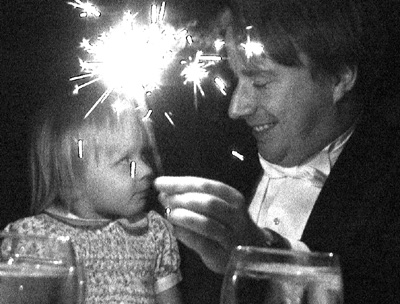Linux Lunacy 2003: Cruising the Big Picture, Part III
The weirdest things about Sitka are its volcanos. When I looked out the cabin window at dawn, the first sights that grabbed my eyes were Mt. Edgecumbe and Crater Ridge, a pair of volcanos clearly of recent vintage. Anything much older than 10,000 years would have been scarred or scraped away completely by ice age glaciers. Mt. Edgecumbe stands around 3200 feet high, and it's the Mt. Fuji of Sitka. It not only resembles Mt. Fuji but shares with it a shape and composition typical of volcanos near subduction faults, where one lithospheric plate slides under another. Alaska features one of the world's longest faults, along the Aleutian archipelago; but it starts more than 1,000 miles to the west of Sitka. So Mt. Edgecumbe just sits there looking like it belongs in Hawaii.
Mt. Edgecumbe hasn't been active for more than two hundred years, although smoke did rise from the volcano on April Fools Day in 1995, when Porky Oliver Pickar torched fifty tires in the caldera.
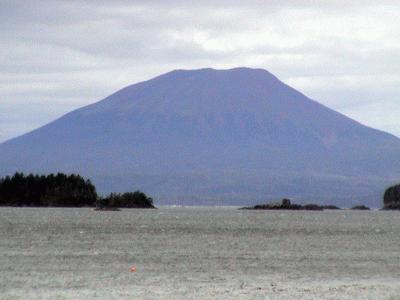
Mt. Edgecumbe, Alaska's Most Tropical Volcano
In the fullness of geologic time, Mt. Edgecumbe is a zit. It showed up nine thousand years ago, shortly after waters covered the Bering land bridge between Siberia and Alaska. By that time the ancestors of today's Native Americans had crossed the bridge and dispersed throughout the Americas. Many remained in Alaska, of course, which means Mt. Edgecumbe is among the world's few volcanos watched by humans since its birth.
Sitka remains a native place, perhaps even more so than other familiar Southeast Alaskan towns. In spite of the prominence of St. Michael's Cathedral, the Russian Orthodox church in the heart of town, the deepest cultural roots clearly are those that predate modern immigrants by many millennia. Tlingit dancers are the main attraction at the town's welcome center. The bus tour we took around town was run by local natives. It was cheap, too, unlike many shore excursion packages sold on the boat. And one gathers that the local history, which is highlighted by both cooperation and conflict between natives and Russian fur traders, ultimately was won by the natives.
For the fourth day in a row, we lucked out on weather. Sitka gets close to 100 inches of rain per year, but none (that I recall) fell on the day we were there. That gave my little group a chance to hang out at St. Michael's, visit the National Historic Park (the first of its kind) and watch salmon spawn in the Indian River. The fish were thick as rocks in the water, which runs through a rain forest. Spawning isn't a pretty process. The river serves as both a hospice and a graveyard for the fish, which lay their eggs then croak, rot and stink on the shores. It was interesting stuff, but that evening few of us had an appetite for salmon.
We had a fun time in Sitka, but the day's highlight came in the evening, when Linus gave his annual State of the Kernel talk. For a while we were afraid he might not get a chance; the captain had announced that large seas were expected until a bit past midnight, when the Amsterdam would round the corner of Baranoff Island and head to the protected waters leading to Ketchican, our next stop on the cruise.
Fortunately, the seas were far less rough than we feared, and Linus' talk went off without a hitch. A transcription of the whole thing will be posted on the LJ site next week.
Later we had a great dinner (with a dutch hat theme), after which we went upstairs to the Lido deck. There again we were treated to spectacular water effects in the main, and very closed, pool.
The rain finally caught up with us in Ketchikan. Odds favored this, as rain falls on the town more than three days out of four. In 2001, Ketchikan totaled nearly 184 inches of precipitation, which is more than fifteen feet. The average is 137.4 inches.
Most of us, myself included, stayed on the boat for the day. I had been to Ketchikan before and found it quite enjoyable--especially the Creek Street Boardwalk, where restaurants and crafts stores have replaced the town's legendary brothels. I'm not normally big on craft shops, but the ones on Creek Street were among the best I've ever seen, with live carving of native sculptures, arrowhead-making and other fun stuff.
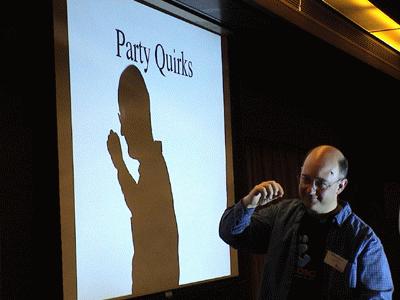
Fun on the Boat Out of Ketchikan
The Ketchikan highlight on the ship was Whose Geek Is It Anyway?, an evening of improv comedy hosted by Steve Oualine. Charles Roth opened the evening by leading a performance of Rick Moen's "Modern SCO Executive". The whole thing was extremely funny.
After the performance we went to the second Formal Dinner on the cruise. The highlight there was watching Linus and Tove being tortured by a violinist in a lounge after the meal.
Several microseconds after Linux Journal announced the itinerary for this cruise, we heard from VLUG, the Victoria Linux Users Group. We harvested the fruits of their labors as soon as we got off the boat in Victoria, British Columbia.
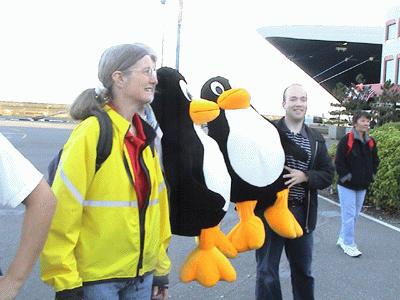
Canada's resident penguin population greets the Lunatics in Victoria.
Our visit to Victoria was about the shortest of the trip, as we arrived not long before sundown. But it also was one of the most fun, both for VLUG and for the lunatics on the cruise.
Before we went ashore to hook up with the VLUG folks, Neil treated us to his annual cruise wrap cocktail party. Mick Bauer arrived in his sports jacket, Defcon shirt and regimental kilt. And the LJ crew gathered for a first & last group photo before we all headed ashore.
The VLUGgers greeted us outside the boat with a pair of giant penguins. If there had been a crowd they would have stood out, but they were the only people in the parking lot, so they were extremely hard to miss.
Soon a large posse of lunatic cruisers were fanning across town in their hosts' vans and cars, getting free personal tours of the town before gathering at the University of Victoria to marvel at the extremely large number of nearly tame rabbits that inhabit the place.
VLUG meets in a large yet intimate lecture hall at the University. There about half of the lunatics sat on stage facing the other half of the lunatics, mixed among fifty VLUGgers in the audience. (I counted: there were 30 of us, 50 of them, 80 overall.) We had a lively Q&A, with many of the questions directed, of course, to Linus. His responses also will be posted on the LJ site next week.
We awoke our last morning back at the dock in Seattle, which was as sunny and warm as it had been on the day we left.
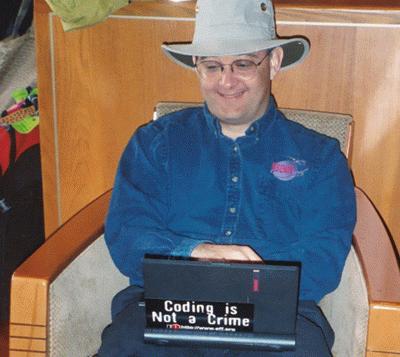
Keith Packard thinks noncriminal thoughts while waiting to disembark.
Ever go to summer camp when you were a kid? If you liked camp a lot, you might get some of the sense of what it was like to come to the end of Linux Lunacy III. Lots of e-mails and business cards were exchanged, along with promises to correspond and get together with old and new friends. The Wi-Fi stayed up right to the last second, so some of us (like Keith, above) were able to continue mainlining packets until our own rear ends were packed back to shore.
For veterans like me, Linux Lunacy has become a festive week in our cult's calendar. It's Christmas and New Year's wrapped into one. But it's something more than pure enjoyment. It's an annual step upward in every attendee's Linux educational development, whether they were novice or advanced when they stepped on board.
Next year's trip, Linux Lunacy IV, is the first to go to Europe. It will depart out of Venice to ports of call in Greece, Turkey, Croatia and Italy. It will be a step up in just about every respect. Given the high standard set by Linux Lunacy III, you have fewer excuses than ever not to go.
We look forward to seeing you there.
Doc Searls is Senior Editor of Linux Journal, covering the business beat. His monthly column in the magazine is Linux For Suits, and his bi-weekly newsletter is SuitWatch.
email: doc@ssc.com


